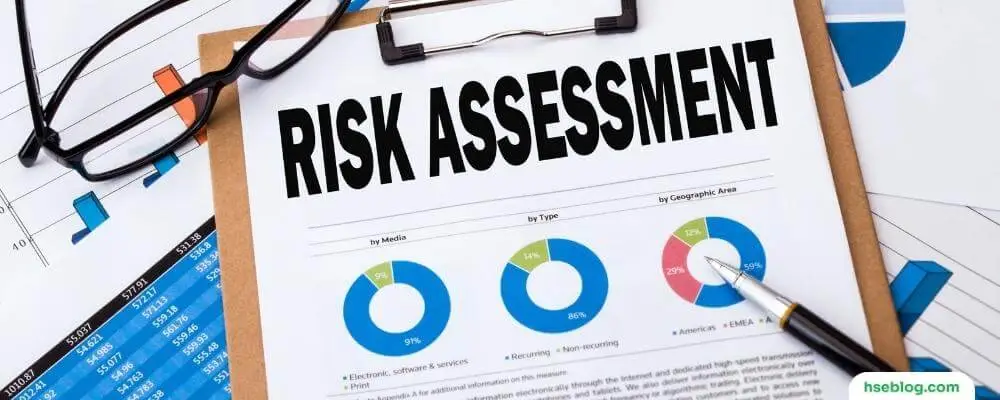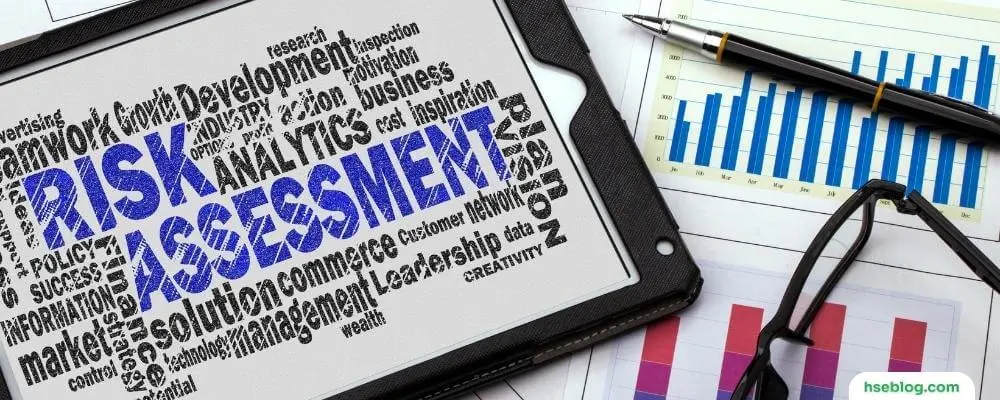Risk assessments are critical for identifying and managing potential organizational hazards and threats. They provide a systematic approach for evaluating risks and developing appropriate risk mitigation strategies to ensure the safety and well-being of workers and assets. However, despite the importance of risk assessments, many organizations still struggle with conducting effective assessments that truly capture the full range of risks.
In this article, we will explore ten reasons why risk assessments are inadequate and offer insights on how organizations can improve their risk assessment practices. From failing to perform a formal risk assessment to neglecting communication during the process, we will cover key areas where risk assessments often fall short. By addressing these shortcomings and adopting best practices, organizations can ensure they conduct effective risk assessments and mitigate potential risks to the fullest extent possible.
Reasons Your Risk Assessments Are Inadequate
There could be several reasons why your risk assessments are inadequate. Here are some common issues that can lead to inadequate risk assessments:
1. Failing To Perform A Formal Risk Assessment
The importance of conducting a formal risk assessment cannot be overstated. Many organizations, however, underestimate its significance and instead rely on intuition, gut feelings, or anecdotal evidence to guide their decision-making process. Such an approach can result in overlooking significant risks, leading to potential harm and financial loss.
Organizations might not carry out risk assessments due to various reasons, including:
- Lack of resources: Some organizations may lack the financial, human, or technical resources to conduct a comprehensive risk assessment. This can lead to an overreliance on informal methods or a complete lack of risk management.
- Believing risks are already managed or don’t need to be managed: Some organizations may assume that they have already taken adequate measures to mitigate risks or that certain risks are insignificant or unlikely to occur. This complacency can result in a failure to identify and address emerging or evolving risks.
- Assuming external parties are responsible: Organizations might mistakenly believe that their insurance carriers or external consultants are responsible for conducting risk assessments. While these parties can provide valuable support and guidance, the ultimate responsibility for risk management lies with the organization itself.
- Lack of regulatory mandates: In some cases, organizations might not be legally required to perform risk assessments. However, this does not absolve them of the responsibility to proactively identify and manage risks to protect their employees, customers, and assets.
- Absence of significant events: Organizations that have not experienced significant adverse events might develop a false sense of security, believing that their operations are inherently safe. This can lead to complacency and a lack of investment in the formal process of risk assessment.
To address these challenges, organizations must develop a clear strategy outlining when, how, and why risk assessments should be performed. This includes allocating sufficient resources, fostering a culture of risk awareness, and engaging with external parties to ensure that risk assessments are comprehensive, systematic, and effective in identifying and managing potential hazards.

2. Failing To Define The Purpose And Scope Of The Assessment
A successful risk assessment relies on clearly understanding its purpose and scope. Without these defined parameters, the assessment can lose focus, resulting in overlooked critical risks or wasted time and resources on irrelevant issues.
The consequences of not defining a clear purpose and scope for a risk assessment include:
- Lack of direction: Without a well-defined purpose, the risk assessment team may struggle to determine their goal, leading to confusion and potentially overlooking important risks. A clear purpose establishes the goals and objectives of the assessment, providing a roadmap for the team to follow.
- Lack of focus: When the scope of the risk assessment is not clearly outlined, it becomes challenging to determine which risks are relevant and which are not. This can lead to the assessment team wasting valuable time and resources on issues with little or no bearing on the organization’s risk profile.
- Inadequate stakeholder input: A well-defined scope ensures that the risk assessment addresses the concerns of all relevant stakeholders. By involving those using the information generated by the assessment, the process is more likely to yield valuable insights and actionable recommendations.
- Ineffective risk management: An unfocused risk assessment may fail to identify key risks or underestimate their potential impact, leading to insufficient or inappropriate risk mitigation measures. This can leave the organization vulnerable to unforeseen events and financial losses.
Organizations must invest time and effort in defining the purpose and scope of their risk assessments to avoid these pitfalls. This involves setting clear objectives, outlining the specific areas to be assessed, and determining the relevant stakeholders to be involved in the process. By establishing a focused and well-defined risk assessment framework, organizations can ensure that their assessments are efficient and effective in identifying and managing potential risks.
3. Failing To Understand The Organization’s Acceptable Risk Level
Organizations have different risk tolerance levels, and failing to recognize and establish an acceptable risk level can lead to either overly cautious or recklessly risky decisions.
Many organizations have not considered or defined acceptable risk levels, leading to unclear expectations and ineffective risk management. Some organizations promote zero-injury goals, which, while well-intentioned, may be unrealistic given that it is virtually impossible to eliminate all risks entirely.
Understanding and defining an acceptable risk level is crucial for the following reasons:
- Balancing risk and reward: Establishing an acceptable risk level helps organizations balance the potential rewards of their activities and the risks involved. This ensures they can make informed decisions that optimize their resources and efforts.
- Prioritizing risk mitigation efforts: When an organization understands its acceptable risk level, it can prioritize its risk mitigation efforts more effectively. This allows the organization to allocate resources to address the most significant risks while accepting those within the acceptable range.
- Guiding decision-making: A well-defined acceptable risk level serves as a benchmark for decision-making, helping organizations evaluate the risks associated with various options and choose the one that best aligns with their risk tolerance.
- Ensuring practicality: In some cases, it may be impractical to reduce risk further, either because the costs outweigh the benefits or because doing so would significantly impede the organization’s operations. By establishing an acceptable risk level, organizations can determine when it is appropriate to accept a certain level of risk based on practical considerations.
To establish an acceptable risk level, organizations should engage in a collaborative process involving key stakeholders, such as management, employees, and safety professionals. This process should consider the organization’s industry, operational context, legal and regulatory requirements, and overall risk management strategy. Organizations can make more informed decisions and implement more effective risk management practices by defining and understanding their acceptable risk level.
4. Failing To Assemble The Best Team To Perform The Risk Assessment
The effectiveness of a risk assessment largely depends on the team responsible for conducting it. A team consisting of individuals with diverse expertise, experience, and perspectives is crucial for ensuring a comprehensive and well-rounded assessment.
A weak risk assessment team can lead to several issues:
- Incomplete identification of risks: Without the right mix of expertise and experience, a team may fail to identify all potential risks, leaving the organization vulnerable to unforeseen hazards.
- Misjudging risk severity: A team lacking diverse perspectives might not accurately evaluate the severity of identified risks. This can lead to inadequate risk mitigation measures or a misallocation of resources.
- Ineffective risk control measures: A risk assessment team that lacks the necessary knowledge and skills may propose risk control measures that are either impractical, insufficient or too costly. This can undermine the overall effectiveness of the organization’s risk management strategy.
- Lack of stakeholder buy-in: A risk assessment team not representing the organization’s various stakeholders may struggle to gain the support and cooperation necessary to implement effective risk management measures.
To assemble the best team for conducting a risk assessment, organizations should consider the following:
- Diverse expertise: Include team members in various aspects of the organization’s operations, such as safety, engineering, finance, legal, and human resources. This ensures that risks are identified and evaluated from multiple angles.
- Experience: Select team members with relevant experience in risk assessment and the organization’s industry and operational context. This helps ensure that the team can identify and address industry-specific risks effectively.
- Representation: Ensure that the team represents various perspectives within the organization, including employees at different levels, departments, and locations. This promotes stakeholder buy-in and helps to identify risks that may be unique to certain areas of the organization.
- Training and competency: Invest in training and development to ensure team members possess the necessary skills and knowledge to conduct a thorough risk assessment.
By assembling a competent, informed, and diverse team, organizations can significantly improve the quality and effectiveness of their risk assessments, leading to better risk management outcomes.

5. Failing To Use The Best Risk Assessment Technique
Numerous risk assessment techniques exist, each with its own strengths and weaknesses. Choosing an unsuitable technique can lead to inaccurate or incomplete assessments, leaving the organization vulnerable to unidentified or improperly managed risks.
Organizations that lack awareness or skill in risk assessment techniques may encounter the following issues:
- Inadequate risk identification: Using an inappropriate technique may result in failing to identify all relevant risks, leading to gaps in the organization’s risk management strategy.
- Inaccurate risk evaluation: Certain techniques may not accurately evaluate the probability or impact of identified risks, resulting in a distorted understanding of the organization’s risk profile.
- Impractical risk controls: An unsuitable risk assessment technique may lead to the recommendation of risk control measures that are either impractical, insufficient or too costly, undermining the effectiveness of the organization’s risk management efforts.
- Inefficient use of resources: Employing an inappropriate technique can result in wasted time and resources. The risk assessment process may need to be repeated or revised to correct the deficiencies.
To avoid these pitfalls, organizations should:
- Research and compare techniques: Conduct research on various risk assessment techniques to determine which are most appropriate for the organization’s needs and operational context. This may involve seeking external guidance or expertise, if necessary.
- Tailor the technique to the organization: Adapt the chosen technique to suit the specific requirements and characteristics of the organization, taking into account factors such as size, complexity, and industry.
- Train the risk assessment team: Ensure team members are familiar with and competent in applying the chosen technique. This may involve providing targeted training or support materials.
- Regularly review and update the technique: As the organization’s needs and risk landscape evolve, it is essential to periodically review and, if necessary, update the chosen risk assessment technique to ensure its continued effectiveness and relevance.
By selecting and implementing the most appropriate risk assessment technique, organizations can enhance the accuracy and comprehensiveness of their risk assessments, resulting in more effective risk management outcomes.
6. Failing To Be Objective And Unemotional During The Assessment
Bias, preconceived notions, and emotional responses can all cloud judgment during a risk assessment. Objectivity and detachment are essential for a successful assessment, ensuring that risks are evaluated based on facts and data rather than personal beliefs.
Factors that may result in a biased or emotion-based assessment include:
- Influence from recent events or trends: Recency bias can cause individuals to overemphasize the importance of recent events or trends, leading to an inaccurate assessment of the likelihood or impact of certain risks.
- Personal experiences: Team members may unconsciously allow their own experiences to influence their evaluation of risks, which can result in a skewed understanding of the organization’s risk profile.
- Personal areas of interest: Team members may focus more on risks related to their own areas of interest or expertise, potentially overlooking other important risks.
- Strong personalities: Dominant personalities within the team may sway the risk assessment process, leading to groupthink or an overemphasis on certain risks at the expense of others.
To mitigate these potential sources of bias and emotion, organizations should:
- Foster a culture of objectivity: Encourage team members to approach the risk assessment process with an open mind and a focus on facts and data. This can be supported through training and guidance on recognizing and addressing potential biases.
- Incorporate diverse perspectives: Assemble a risk assessment team representing a wide range of expertise, experiences, and perspectives to ensure a more balanced and comprehensive assessment.
- Use data-driven approaches: Employ risk assessment techniques that rely on quantitative data, where possible, to reduce the influence of subjective opinions and emotions.
- Encourage open dialogue and debate: Facilitate a transparent and inclusive risk assessment process where team members feel comfortable sharing their views and challenging one another’s assumptions.
Organizations can minimize the influence of biases and emotions by maintaining objectivity and detachment during the risk assessment process, leading to more accurate and effective risk management outcomes.
7. Failing To Identify Hazards And See Combined Whole System Risk
Risk assessments focusing solely on individual hazards can overlook the cumulative effects or interactions between hazards. This may lead to an incomplete understanding of the organization’s overall risk landscape and inadequate risk management strategies.
Understanding and addressing combined whole system risk is crucial for several reasons:
- Uncovering hidden risks: Focusing on individual hazards may not reveal the full extent of an organization’s risks. Organizations can uncover hidden risks that would otherwise go unnoticed by considering how hazards interact and their cumulative effects.
- Identifying risk dependencies: Understanding the relationships between different risks can help organizations recognize risk dependencies and the potential for cascading effects. This allows for developing more comprehensive risk management strategies that address the root causes of interconnected risks.
- Improving resource allocation: By considering the combined impact of multiple risks, organizations can allocate resources more effectively, prioritizing risk mitigation efforts where they are most needed.
- Enhancing risk mitigation strategies: Understanding the interactions between hazards can help organizations develop more robust and effective strategies, considering the potential for risks to influence one another.
To address combined whole system risk, organizations should:
- Assemble a diverse team: A risk assessment team with diverse expertise and perspectives is better equipped to identify a wide range of potential risks and consider their interactions.
- Use a holistic risk assessment approach: Employ techniques that encourage a comprehensive view of the organization’s risk landscape, considering individual hazards and their cumulative effects and interactions.
- Encourage cross-functional collaboration: Facilitate collaboration between different departments and functions within the organization to ensure a more thorough understanding of how risks may impact one another.
- Regularly review and update risk assessments: As new risks emerge or existing risks change, reviewing and updating them is essential to ensure they reflect the organization’s evolving risk landscape.
By taking a whole system approach to risk assessment, organizations can gain a more comprehensive understanding of their risk landscape, enabling them to develop more effective and resilient risk management strategies.

8. Failing To Consider The Hierarchies Of Controls Or Prioritize By Risk
Once hazards have been identified, it is crucial to prioritize them according to their potential impact and apply the appropriate controls. Neglecting this step can result in wasted resources and insufficient risk mitigation.
The hierarchy of controls is a widely accepted approach to managing risk by applying controls in a prioritized manner, from most to least effective. The hierarchy includes:
- Elimination: Removing the hazard entirely from the workplace or process.
- Substitution: Replacing the hazardous material or process with a less hazardous one.
- Engineering controls: Designing or modifying the workplace or equipment to reduce exposure to the hazard.
- Administrative controls: Implementing policies, procedures, and training to reduce the risk associated with the hazard.
- Personal protective equipment (PPE): Providing workers with appropriate PPE to reduce exposure to hazards.
Failing to consider the hierarchies of controls and prioritize by risk can lead to several issues:
- Inefficient use of resources: Resources may be allocated to less effective controls, leading to reduced risk mitigation effectiveness and potential waste.
- Inadequate risk mitigation: Overreliance on lower-level controls, such as PPE, may not provide sufficient protection against the identified hazards, leaving workers exposed to risks.
- Lack of sustainability: Lower-level controls may not address the root cause of the hazard, resulting in the need for ongoing management and potential future incidents.
To effectively prioritize and apply controls, organizations should:
- Assess risk levels: Evaluate the potential impact of each identified hazard to prioritize which risks require immediate attention and determine the most appropriate controls.
- Apply the hierarchy of controls: When selecting controls, consider the hierarchy of controls and prioritize the implementation of higher-level controls, which are typically more effective and sustainable.
- Monitor and review controls: Regularly monitor the effectiveness of implemented controls, and make adjustments as necessary to ensure ongoing risk mitigation.
- Engage stakeholders: Involve workers and other stakeholders in the decision-making process for selecting and implementing controls, as they may have valuable insights into potential solutions.
By considering the hierarchies of controls and prioritizing by risk, organizations can more effectively allocate resources, implement appropriate risk mitigation strategies, and enhance their workforce’s overall safety and well-being.
9. Failing To Perform Risk Assessment During The Design/Redesign Stage
Risk assessments should be conducted throughout the lifecycle of a project, including during the design and redesign phases. Neglecting risk assessments at these stages can lead to the oversight of potential risks and result in costly revisions and modifications later.
Performing risk assessments during the design/redesign stage is imperative for the following reasons:
- Early risk identification: By conducting risk assessments during the design or redesign phase, organizations can identify and address potential risks early. This allows for proactive risk management, preventing hazards from being built into the project and reducing the likelihood of incidents or accidents.
- Cost-effective risk mitigation: It is generally more cost-effective to address risks during the design stage rather than later in the project lifecycle. Design changes are typically less expensive and disruptive than modifications made during construction or operation. Early risk assessment enables organizations to incorporate appropriate risk mitigation measures into the design, saving time and resources in the long run.
- Optimization of design decisions: Risk assessments conducted during the design phase provide valuable insights that can inform design decisions. Identifying and mitigating risks early on allows for optimizing design elements to enhance safety, efficiency, and overall project success.
- Compliance with regulations and standards: Many regulatory bodies and industry standards require risk assessments during the design phase. Failing to conduct these assessments can result in non-compliance and legal or regulatory consequences.
To ensure effective risk assessments during the design/redesign stage, organizations should consider the following:
- Involve multidisciplinary teams: Engage professionals from different disciplines, such as design, engineering, safety, and operations, to collectively assess potential risks and develop appropriate risk mitigation strategies.
- Utilize design tools and methodologies: Employ design tools, such as hazard analysis techniques, failure mode and effects analysis (FMEA), or computer-aided design (CAD) software, to systematically identify and address potential risks during the design phase.
- Integrate risk assessment into the design process: Incorporate risk assessment activities as an integral part of the design process, ensuring that risk analysis and mitigation become routine components of design decisions.
By performing risk assessments during the design/redesign stage, organizations can proactively identify and mitigate potential risks, leading to safer, more efficient, and successful projects with reduced likelihood of costly revisions or modifications.

10. Failing To Communicate Before, During, And After The Assessment
Effective communication is essential for the success of any risk assessment. Organizations can address concerns, gather valuable input, and develop a more effective and accepted risk management strategy by keeping stakeholders informed and engaged throughout the process.
The importance of communication in risk assessment can be understood in the following ways:
- Pre-assessment communication: Before conducting the risk assessment, it is crucial to communicate with stakeholders to ensure their understanding of the assessment process, objectives, and expected outcomes. Defining roles, responsibilities, and expectations helps establish a collaborative and supportive environment.
- During-assessment communication: Ongoing communication during the assessment ensures that all team members understand the process, share information effectively, and address any emerging issues or challenges. Regular communication and feedback among team members help maintain alignment and consistency in the assessment process.
- Stakeholder involvement: Engaging stakeholders throughout the assessment fosters their ownership of the process and increases the likelihood of their acceptance and cooperation with the resulting risk management strategies. Organizations can tap into their knowledge, experience, and perspectives by actively involving stakeholders, leading to a more comprehensive and realistic assessment.
- Post-assessment communication: After completing the risk assessment, it is essential to communicate the findings, conclusions, and recommended risk mitigation strategies to relevant stakeholders. Transparent and timely communication of assessment outcomes enables stakeholders to understand the risks, contribute to decision-making, and implement appropriate risk controls.
To ensure effective communication throughout the risk assessment process, organizations should consider the following:
- Plan and establish a communication strategy: Develop a clear plan for communication, identifying the key stakeholders, their roles, and the methods and frequency of communication.
- Tailor communication to the audience: Adapt the communication style and content to suit the needs and understanding of different stakeholders. Present technical information in a way that is accessible and relatable to diverse audiences.
- Foster a culture of open communication: Encourage open dialogue and active listening where team members and stakeholders feel comfortable expressing their thoughts, concerns, and ideas. Create channels for feedback and encourage two-way communication.
- Utilize various communication channels: Employ a mix of communication channels, such as meetings, presentations, reports, and digital platforms, to reach different stakeholders effectively.
Organizations can ensure that stakeholders are well-informed, engaged, and empowered to contribute to the risk management process by prioritizing communication before, during, and after the risk assessment. Effective communication enhances understanding, cooperation, and acceptance of risk assessment outcomes, leading to more successful risk management strategies.
Conclusion
Effective risk assessments are vital for organizations to identify, analyze, and mitigate potential risks impacting their operations and objectives. However, inadequate risk assessments can leave organizations vulnerable to unforeseen hazards and hinder their ability to implement effective risk management strategies. Organizations can gain valuable insights into areas where improvements are needed by exploring the ten common reasons behind inadequate risk assessments discussed in this article.
From the failure to perform formal risk assessments to the lack of expertise, data-driven analysis, and communication, each reason highlights a critical aspect that organizations must address to enhance their risk assessment practices. Additionally, organizations should be mindful of emerging risks, integrate risk assessments into decision-making processes, and prioritize documentation and record-keeping for traceability and accountability.
Improving risk assessment practices requires a commitment to continuous learning, engagement of relevant stakeholders, and applying robust methodologies and tools. By recognizing the shortcomings in their risk assessment processes and taking proactive steps to address them, organizations can bolster their risk management efforts, enhance their resilience, and safeguard their long-term success.
Effective risk assessments are not standalone events but an ongoing process that requires constant monitoring, evaluation, and adaptation. By embracing a culture of risk awareness and continuous improvement, organizations can stay proactive, agile, and better equipped to mitigate risks and seize opportunities in an increasingly complex and dynamic business environment.

